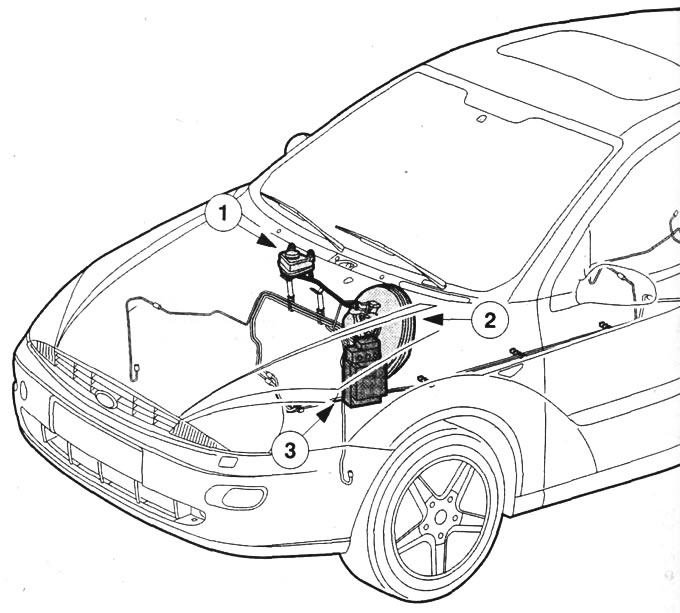
Focus brake system controls are installed under the hood: 1 - expansion tank with brake fluid; 2 - active brake booster with integrated brake master cylinder, 3 - ABS control module.
In the procedure for admission of rolling stock to movement on roads and streets (StVZO) two brake systems operating independently of each other are prescribed (foot and parking brake). Cause: If one brake system fails, the other still brakes with reduced power. The service brake in your Focus is additionally divided diagonally - each brake circuit acts on one front and one opposite rear wheel: if one circuit fails, one front and one rear wheel of the other circuit remains fully functional. With only one active brake circuit, your Focus decelerates significantly more slowly, but still stops. You will notice the failure of one circuit not only by the lengthened braking distance, but also by the lengthening of the brake pedal travel and by the burning control light on the dashboard.
Brake system anti-lock wheels (ABS), system (automatic) drive wheel traction control (BTCS), electronic brake force distribution (EBD), electronic vehicle stability program (ESP).
ABS and BTCS enhance active driving safety. EBD replaces the mechanical brake force regulator. The ABS function ensures complete controllability even under full braking. BTCS improves directional stability when accelerating on slippery roads. As another active safety feature in today's compact cars, electronic brake force distribution is becoming more and more common (EBD). EBD is activated before ABS and improves braking stability by electronically fine-tuning rear wheel slip. The anti-lock wheel braking system used in the Focus contains an electronic and hydraulic control module (HECU). Both systems are housed in a common aluminum case. To accurately determine the number of wheel revolutions, HECU uses one sensor per wheel: EBD and BTCS use the same signals. The HECU operates with eight solenoid valves, a hydraulic pump driven by a DC motor and two vacuum manifolds. In the Focus, the wheels are individually adjustable up to 120 km/h. On the rear axle, this is done in parallel: the wheel that tends to block first is the model. With ABS system errors. EBD and BTCS are disabled - in this case, the brakes work without electronic support, like a conventional brake system. You can find out about a malfunction by the ABS warning light: it does not go out after a mandatory self-test. ABS in Focus is fully diagnosed. Defect codes are archived in a permanent storage device. In addition, Ford supplies all Focus models from 1.6L with ESP as special equipment.
Electronic dual-circuit pump doses the braking power
Braking energy is distributed in the system by an electronic dual-circuit pump. Each of the four separate control channels has a pair of solenoid valves (one inlet and one outlet). Inlet valves are usually open and provided with a switchable orifice (small hole for fine adjustment of the passage of a small amount when the brakes are applied, large hole for minimum flow resistance during normal braking function).
HECU controls ABS functions
The HECU manages the ABS functions, calculates the driving speed based on the signals from the wheel speed sensors, monitors all electrical components and stores malfunction data in memory. With the ignition on, the system performs a self-test called by the HECU before driving. In driving mode, the electrical connections are constantly monitored. In this case, a polarity check is carried out, as well as a check for the presence of short circuits and conduction disturbances. The solenoid valves are also checked regularly to check the ABS function, for this the system sends a test pulse. Possible malfunctions are quickly and specifically read out by your Ford dealer using the FDS 2000 control unit.
EBD limits rear wheel slip
EBD constantly compares the slippage of the front and rear wheels and doses or distributes the braking force accordingly. Normally EBD operation is not felt, its technology implements - regardless of the vehicle's load condition - minimal braking distances. In addition, EBD replaces the traditional brake force regulator in the system.
BTCS active up to 50 km/h
BTCS is integrated into the ABS Focus with two shut-off solenoid valves and two hydraulic intake valves. The system is activated if necessary at speeds up to 50 km/h. It remains active for as long as required for starting off and accelerating on slippery roads. BTCS provides good front wheel traction. This also improves the steering quality during smooth acceleration from standstill and especially during cornering manoeuvres. If the BTCS detects slippage on one front wheel, it will automatically brake until the spinning wheel regains traction.
ESP brakes individual wheels automatically
ESP stabilizes driving performance in the marginal ranges of driving dynamics. The system supports the driver in the desire to keep the vehicle on course more reliably by intervening specifically in the braking of individual wheels or by adjusting the engine management. But contrary to all theoretical reflections on the absolute safety of movement, ESP cannot cancel the boundaries of the physics of movement: where the head does not initially work, even the most modern chassis electronics will not help.
Visitor comments